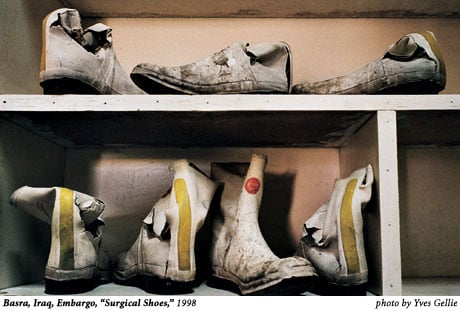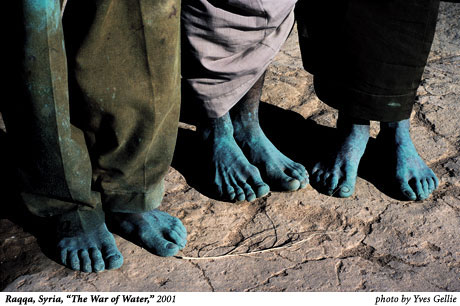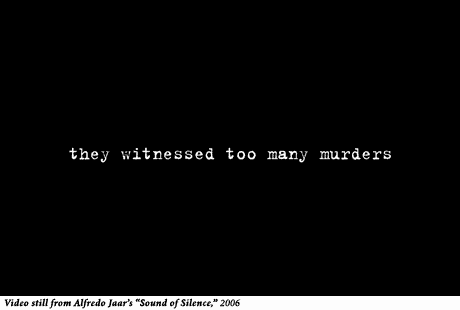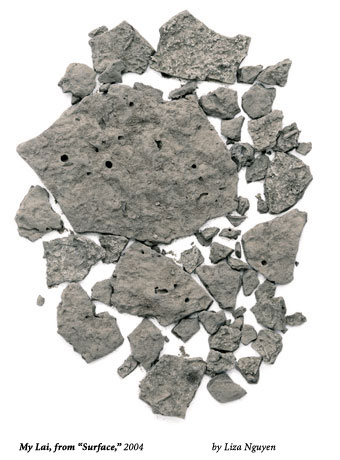A Frontal Attack is Not the Best Idea
An image can cause an erection or a tear, but can it kill a man or stop a war?
After looking around FotoFest, the huge, international photography biennial happening now all over Houston, you have to ask. This is the organization’s 11th expo, and directors Wendy Watriss and Frederick Baldwin have never been less content to stay inside the picture frame. In keeping with the themes of FotoFest 2006—the Earth and Artists Responding to Violence—the quantity and quality (and in many exhibits, the scale, too) of the photographs are immense, but this time, the ideas are bigger still.
“Violence is what we’re getting media-wise, from news to video games,” says Baldwin, an ex-Marine and documentary photographer. With the competitive frenzy to find the most garish picture and poke it in the public eye, news companies have abandoned the inevitably slower labors of investigation and understanding. Supersaturated with displays of death and horror, viewers rarely ask why violence occurs or what its consequences are. Instead, Baldwin says, “Violence has been converted into ratings and entertainment.”
FotoFest’s own exhibitions on the theme, concentrated at its building on Vine Street, take another approach. Co-curators Watriss and Baldwin have found photographers of subtlety whose works, for the most part, turn aside fire and spattered blood. To confront the nature of violence, “a frontal attack is not the best idea,” says Baldwin. Instead the curators have tried to shift people’s perceptions. They solicited not violent imagery but more conceptual photography, images that explore how violence can be shaped in the crucible of art. “Artists are thinking about issues over a long period of time,” he explains. Their work is “coming out of a whole complex of experience. It may take years to develop a point of view.”
Such is very directly the case with Paula Luttringer. Luttringer was kidnapped during the “Dirty War” in Argentina in the 1970s, one of an estimated 30,000 people whom the government “disappeared” and kept captive in secret detention centers. A botanist, she was held for five months before going into exile. It was only many years later that she addressed her experience through photography.

In 2000, Luttringer began interviewing other women—50 in all—who had been kidnapped. She then went to their former jails with her camera. Her piece “El Lamento de los Muros” (“The Wailing of the Walls,” 2000-2005) is on view at the FotoFest headquarters.
How do these images “respond to violence”? The square, black-and-white photos taken inside Argentina’s once-secret prisons are instantly nightmarish. In one, the shadow of an unseen figure looms behind slats of light. In another, plaster has crumbled onto a dark stair. A wall bears traces of tedious, angry scratchings. An iron brace (a shackle?) hangs on a water-stained wall. In one piece, an ant, hugely magnified, is silhouetted against a grainy floor.
These images, strong as they are, could register as familiarly “grim” or “spooky”—like stills from the cult movie The Blair Witch Project—except that each is paired with an excerpt of personal testimony.
It was very hard to describe the terror of the minutes, hours, days, months spent there. At first when you’ve been kidnapped you have no idea about the place around you. Some of us imagined it to be round, others like a football stadium with guards walking above us. We didn’t know which direction our bodies were facing, where our head was, where our feet were pointing. I remember clinging to the mat with all my strength so as not to fall even though I knew I was on the floor. —Lilliana Callizo, abducted 9/1/76 in Cordoba, taken to the secret detention center “La Perla” (From “El Lamento de los Muros,” “The Wailing of the Walls”, Paula Luttringer, 2000-2005)
Seen again, next to Callizo’s account, the photographic details assume another meaning. Memories of violence “cling” to these ugly particulars, as did the women themselves. Ledda Barreiro told Luttringer about watching ants crawl through her isolation chamber. “They were walking across the earth, the outside world, then coming back in again, and watching them, I didn’t feel so alone.”
Luttringer writes that she began this photography project with doubts: “I thought that no one who had not lived through it would be able to understand what I had to tell.” “The Wailing of the Walls” seems like a kind of reunion in which the ghosts of Argentina’s Dirty War recover their identities, their dangling feet touch the ground.
Juan Manuel Echavarría also responds to violence by giving its victims a theater within his art. In Echavarría’s videos “Bocas de Ceniza” (“Mouths of Ash”), we see in tight close-ups the faces of seven residents of Bojayá, Colombia. One by one, they sing their stories of May 2, 2002.
The day I will never forgetthat changed the whole world.
On that day, the village was overrun by Colombian guerillas and right-wing paramilitaries. Spilling out of the jungle, the combatants took their fight into the town. After people filed into the local church for safety, the guerillas dropped a firebomb on the sanctuary, killing 119.
“Mr. President, don’t you feel pain?” Rafael Moreno sings with a steady, tender voice.
“The chickens cried as they saw their town destroyed,” a young man sings with brimming eyes.
Photography, more than other media, seems especially graced and burdened by conscience. Susan Sontag, who wrote so brilliantly about this medium, argues in her final book, “Photographs are a means of making ‘real’ (or ‘more real’) matters that the privileged and the merely safe might prefer to ignore.” But, as Sontag and others have explored, photography ordinarily performs its magic realizations in ways that preserve that privilege and safety. To see suffering at a distance arouses compassion, even terror, but ordinarily only to satiate viewers with their own righteous anger.
Echavarría’s piece doesn’t accord us that moral luxury. As they perform their ballads, each singer looks directly at us. “Don’t you feel pain?” Pathos and empathy give way to something much less comfortable—possible complicity. For someone like me, who had never known of the massacre in Bojayá, Moreno’s question comes as an accusation—of ignorance or, worse, a convenient blindness. Can you watch the two brothers stifle tears after singing about how they were saved from death by God? Or do you need to look away?
Not all the works that take up the subject of violence do so with such care, imagination, and power. At FotoFest 2006, you’ll find the inevitable reflexes—swastikas, mannequins (some by Echavarría, actually), and snarling dogs—but many more of the works are thoughtful and strong.

Yves Gellie of France, who worked for years as a photojournalist in Syria and Iraq, stepped away from “the action” to make other kinds of pictures, showing how deeply every part of life in that region has been deformed. Thanks to the news media, we’ve become accustomed to seeing charred trucks and corpses. Gellie instead photographs life and landscape on the outskirts of battle. He shows us two surgeons in blue masks and scrubs amid a crowd of veiled women, descending like black waves into a tiny hospital office after the fall of Baghdad. In Raqqa, Syria, he turns his lens downward, toward a patch of parched land and the bare feet of three farmers. Copper sulfate, used to fertilize this barren soil, has turned their feet lapis blue.
In her last book, Regarding the Pain of Others, Sontag writes, “We want the photographer to be a spy in the house of love and death.” Alfredo Jaar’s “The Sound of Silence”—the featured work commissioned for this year’s FotoFest—confronts this expectation head-on. Jaar’s 8-minute video examines one such “spy,” South African photojournalist Kevin Carter.
Carter covered the civil wars of apartheid during the ’80s and ’90s, making a name for himself as one of a bold bunch of young, white documentary photographers: “The Bang Bang Club.” In 1994, he traveled to the Sudan, then in the midst of famine, and won a Pulitzer Prize for his photograph of a starving Sudanese child crawling across bare ground under the gaze of a vulture.
Jaar’s video is shown inside a tiny theater especially built for the piece within the main gallery at DiverseWorks. As the video begins, lines of white lettering—reminiscent of a field typewriter with a worn out ribbon—surface and fade across a black screen.
kevin
kevin
kevin carter
His name throbs in the dark, a silent incantation. Jaar recounts the photographer’s life story with terse, poetic lines of text—not images.
they took many risks [we’re told of Carter and his fellow photographers]
they witnessed too many murders
they survived too many murders

Carter’s photograph from the Sudan, we are not surprised to learn, elicited more than awards; it stirred outrage and accusations that this image—or rather the making of the image—was itself hideous and predatory. “The man adjusting his lens to take just the right frame of her suffering,” wrote the St. Petersburg (Florida) Times, “might just as well be a predator, another vulture on the scene.”
Two months after claiming his Pulitzer Prize in New York, Kevin Carter attached a hose to the exhaust pipe of his truck and committed suicide. Flash. A burst of light from nowhere shocks and momentarily blinds us in the theatre. As all eyes adjust, Carter’s controversial image fills the screen.
Jaar’s text goes on to describe the property rights now in place around the famous image. The photograph belongs to Carter’s daughter but is managed by the immense Corbis archive:
the reference number of this photograph is Corbis 0000295711-001
Corbis is owned by Bill Gates
no one knows what happened to the child
The auditorium at DiverseWorks was packed on March 12 to hear Alfredo Jaar and others discuss “The Sound of Silence.” FotoFest co-director Wendy Watriss (herself a former photojournalist) began by reading a war correspondent’s reflection on his work:
It was his deep suspicion that there was no way actually to make a true, deep passage through the fierce experience of another people, another place, without being seriously touched yourself, possibly even damaged. Real understanding probably had to be personally expensive in some important way.
There is a sense—especially strong among photographers, I think—that images of pain are contraband, that without some personal price, and a high one at that, such pictures constitute a theft. Jaar told the Houston audience that he never intended to romanticize Kevin Carter’s life or death, yet his video seems to do just that. Carter’s suicide became the “personally expensive” price of having sought and captured—and then been publicly honored for—images of suffering. By his suicide, Carter restored the moral balance. He became a martyr, the victim of his own Promethean ambitions. He’s also the victim of our own desires—we, the image-consumers, who must have our “spies.” He died for our sin.
(Interestingly, among the short films nominated for an Academy Award this year was Dan Krauss’s The Death of Kevin Carter: Casualty of the Bang Bang Club. The suicide of a successful photographer of war and famine seems to fulfill our expectation of the spy and the martyr—what Sontag once referred to as “the artist as exemplary sufferer.” Carter seems on the way to becoming photojournalism’s Sylvia Plath.)
“The Sound of Silence” is powerful and provocative, but as Jaar’s own response to violence, it is also a telling deflection. People who saw Kevin Carter’s photograph in the New York Times wrote to him and to the newspaper asking, “What happened to the child?” Jaar’s video displaces the earnest answering of that question. Instead, it seeks to answer another question, “What happened to Kevin Carter?” (and to his photograph). During the intense discussion in Houston after his video was shown, Jaar talked about photographing war in Rwanda, bringing his images back to New York, and discovering that no one was especially interested. “Is it a sign of indifference or are images the causes of indifference?” he asked. “Images come at us without warning, without mercy,” he declared. Photographers must find “new strategies to contextualize images so they have an effect.” In a world of photo-plenty, how will images regain their power?
At this year’s FotoFest, anyone with eyes to see will find scores of answers. More than 100 photography shows and events across the city are on view in spaces as grand as the Museum of Fine Arts and as intimate as a hair salon. It would take a solid week of nonstop gallery visits to take it all in (I managed to see about a tenth of the shows), but some enormously ambitious works not to be missed are on view at the FotoFest offices, 1113 Vine St. Here are many of the pieces that Watriss and Baldwin solicited for this biennial—the works by Luttringer, Gellie, and Echavarría—and more perspectives on the violence theme from photographers of Russia, Sweden, the United States, Germany, and Australia.
One of these is Liza Nguyen. Born in 1979 and raised in Paris by French and Vietnamese parents, Nguyen began studying the history in Vietnam several years ago. Discovering that 2004 was the 50th anniversary of the battle at Dien Bien Phu, when the defeated French withdrew from Vietnam, Nguyen was startled that the anniversary received little attention in France. She decided to travel to Vietnam herself and to visit Dien Bien Phu and 18 other battlefields across the country. What had become of these places? What traces of war would there be decades after the fact?

Nguyen returned to France with photographs and 19 sacks of earth—”souvenirs” of My Lai, Da Nang, Dien Bien Phu…. Using a “macrolens,” she then photographed these bits of earth in her studio, producing the stunning works now exhibited in Houston. The mounds of dirt have been spread in gentle ovals and shot from above, each handful of soil pictured separately, magnified five feet high. What’s astonishing, at first, is how very different they all are—and why wouldn’t they be? Each was a special circumstance, where different people perished and survived. Each is a kind of thumbprint.
The “souvenir” from My Lai is gray and as sharp edged as broken crockery. The soil from the DMZ has been pounded down to small, silver grains; from a distance, it looks like breath on a cold window. From Hue, where there were mass killings by the North Vietnamese, the earth is the color of charcoal. And from Cu Chi, where the Viet Cong hid in a network of tunnels, the soil is as crumbly as brown sugar.
Was possession of this earth what people killed and died for? Decades later, is it still contaminated with Agent Orange, which poisoned many thousands of Vietnamese as well as U.S. soldiers? Nguyen’s images, studious and spare, are worlds apart from the skulls and screaming faces on view elsewhere
at the Vine Street galleries. Each oval handful of soil assumes the shape o
a human face, a brain, a mind. “You have to think,” Nguyen says of her images. “You have to wonder. What happened there?” On her visit to My Lai, Nguyen found “only a field of peasants” and,in a country cemetery, a man drying beans on a sheet. “My question is, why?” she asks.
Photography’s powers of enchantment were once immediacy and speed. It could take us straight into a moment that occurred a century ago or a continent away. Now that trick’s grown tired. Or maybe we have. Just leafing through a magazine, aren’t you dazed, having spun around the world several times? “Images cannot be more than an invitation to pay attention,” Sontag wrote, “to reflect, to learn, to examine the rationalizations for mass suffering offered by established powers.”
But thinking is so much slower than shooting, whether with a camera or a rifle. The new task of photography is to slow us down. But, it turns out, that’s much harder to do.
Julie Ardery frequently writes about the arts. She lives in Austin.


